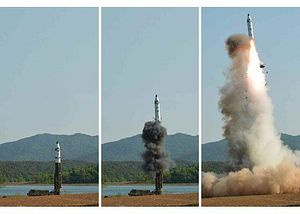On Tuesday, the U.S. Department of the Treasury announced new sanctions on two North Korean officials who play a role in the country’s ballistic missile programs. The U.S. Treasury sanctions, which include designations under Executive Order 13687, come days after the United Nations Security Council unanimously voted to adopt resolution 2397, which expands sanctions on North Korea’s economy. Executive Order 13687 targets North Korean officials and senior members of the Workers’ Party of Korea.
“Treasury is targeting leaders of North Korea’s ballistic missile programs, as part of our maximum pressure campaign to isolate [North Korea] and achieve a fully denuclearized Korean Peninsula,” Steve Mnuchin, the U.S. Treasury secretary, said in a statement. “These actions follow Friday’s United Nations Security Council Resolution, which imposed strong new sanctions on North Korea further shutting down its ability to raise illicit funds.”
The two figures included in the new sanctions, Kim Jong-sik and Ri Pyong-chol, were designated in resolution 2397. Both Kim and Ri worked at the cutting edge of North Korea’s fast-advancing indigenous ballistic missile programs and are involved with the Workers’ Party of Korea’s Munitions Industry Department (MID), according to a U.S. Treasury release. Kim is a deputy director at the MID while Ri is the first vice department director of the Workers’ Party of Korea Central Committee.
Kim is thought to have led research and development work on the country’s burgeoning solid-fuel ballistic missile program while Ri is thought to be a critical player in North Korea’s development of intercontinental-range ballistic missiles (ICBMs), according to the U.S. Treasury.
In 2017, North Korea introduced the Pukguksong-2/KN15, a solid-fuel medium-range ballistic missile. In May, North Korean Supreme Leader declared the KN15 fully operational and ordered its mass production.
The system is based on North Korea’s Pukguksong-1/KN11 solid-fuel submarine-launched ballistic missile, which was successfully flight tested last year in a solid-fuel configuration. That missile was North Korea’s first strategic missile system to use solid propellants. Solid propellants grant land-based missiles greater responsiveness and improve their survivability compared to the liquid-fueled counterparts, which need to be fueled prior to launch.
Also in this year, North Korea tested two separate ICBM designs. It tested the Hwasong-14 ICBM twice in July, with the first launch of that missile marking North Korea’s first-ever successful flight-test of an ICBM. In November, North Korea also tested the Hwasong-15, a larger and more capable ICBM that the U.S. intelligence community assesses is capable of striking any point on the U.S. mainland depending on the missile’s payload weight. The Hwasong-15’s launch led to the latest round of UN Security Council sanctions.

































